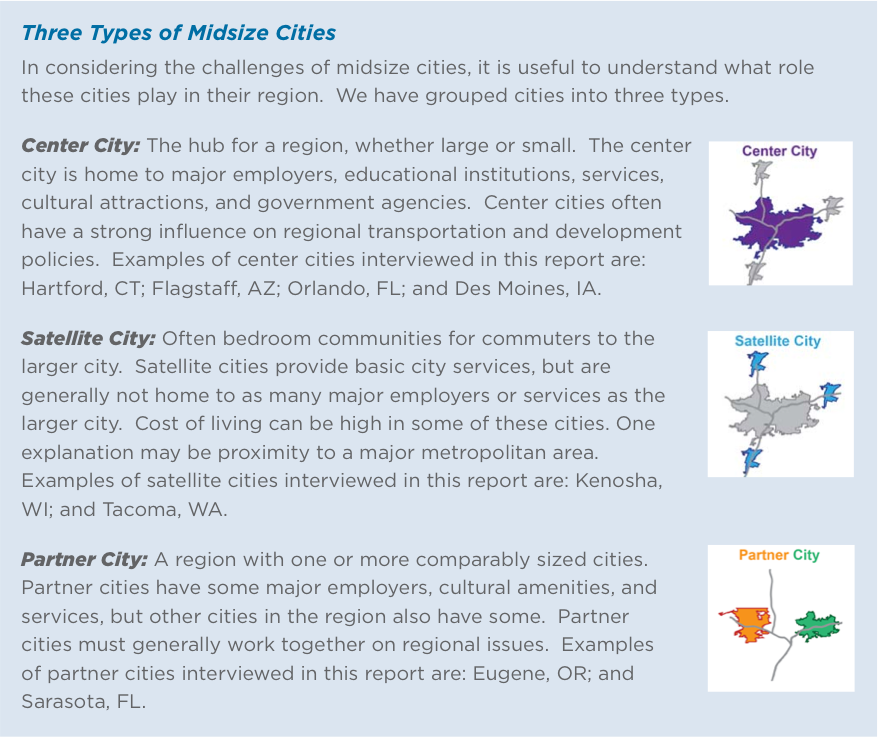RECONNECTING AMERICA
Introduction
Public transportation investments have helped to shape many of America’s cities. The largest metropolises typically have extensive rail and bus systems that provide mobility for commuters, residents, and visitors and serve as the backbone of the regional economy. The recent shutdown of the New York subway system as a result of Hurricane Sandy, and the crippling gridlock that resulted, demonstrates the extent to which such cities depend on their transit systems. The benefits of such systems are well documented; New York’s subway, the DC Metro, Chicago’s “L” trains, and other large systems have been the subject of numerous studies of their economic and environmental impact.
At the other end of the spectrum, transit systems in small towns and rural areas have also been the subject of recent research, including “Exploring the Role of Regional Transportation Projects as Rural Economic Drivers” by the National Association of Development Organizations (NADO) and Reconnecting America’s own report, “Putting Transit to Work in Main Street America: How Smaller Cities and Rural Places Are Using Transit and Mobility Investments to Strengthen Their Economies and Communities.” In these more rural areas, transit serves to overcome large geographic distances and limited transportation options for residents.
In this report we focus on the overlooked “middle” of America’s cities: those that are too small to be among the top tier, but too big to qualify as small towns. These cities can range in size from 50,000 to 250,000 in population. They are not merely smaller versions of large metropolises, nor are they just “bigger” small towns. Midsize cities are a stand-alone group, with their own unique set of amenities and challenges. Yet, like their larger and smaller counterparts, they too have invested in the development of transit systems to serve their communities. More than 250 transit systems serve midsize cities in the US, providing more than 1.5 billion trips each year. The backbone of the transit network in most midsize cities is bus service, which in some cases extends into the larger region. This bus service may be complemented by express or commuter service, paratransit for individuals with disabilities, and other special services.
The success of these systems, and continuing challenges in addressing residents’ mobility needs, has led local leaders in some midsize cities to take a new approach to transit. Across the country, midsize cities are investing in new rapid
bus systems, bus rapid transit, streetcars, and other improvements to better connect suburbs with city centers, to move people between employment centers, and to improve overall connectivity among key destinations. These new transit investments promise to bring not only improved mobility for local residents, but can also be the catalyst for community revitalization, economic development, and improved connectivity between the transit system and surrounding community uses.
This report explores that “next generation” of transit in midsize cities, with a focus on best practices in transit planning, funding strategies, and actual or projected outcomes. The goal is to provide elected leaders, planners, and other stakeholders at the local, regional, state, and federal levels with examples of innovative transit in midsize cities that they can draw upon to improve transportation options in their own communities.
Read full report (PDF) here: Midsize Cities on the Move
About Reconnecting America
www.reconnectingamerica.org
“Reconnecting America is a national nonprofit that advises civic and community leaders on how to overcome community development challenges to create better communities for all. Reconnecting America develops research and innovative public policy, while also building on-the-ground partnerships and convening players needed to accelerate decision-making. The community where we live holds a special place in our hearts. Some of us still live in the same neighborhood where our family has had roots for generations. Some of us choose a community with an eye toward a new beginning. Where we live matters.”
Tags: Bus Rapid Transit, Midsize Cities, Next Generation, Rapid Bus, Reconnecting America, Streetcar







 RSS Feed
RSS Feed